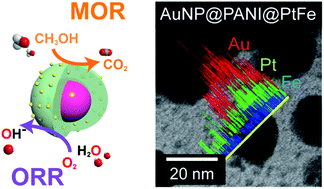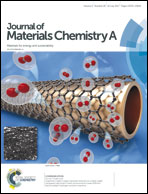PtFe nanoparticles supported on electroactive Au–PANI core@shell nanoparticles for high performance bifunctional electrocatalysis†
Abstract
The design of cost-effective and efficient catalysts requires not only reduced usage of precious metals such as Pt, but also enhanced catalytic activity and stability, which are immensely important for applications in fuel cells and metal–air batteries. Multimetallic core@shell nanoparticles (NPs) consisting of Au core and metal-containing polyaniline (PANI) shells were prepared. These PANI coated AuNPs were sequentially mixed with selected transition metal precursors and platinum precursor solutions followed by chemical reduction to obtain uniformly distributed metal NPs on a surface with reduced Pt usage. We systematically investigated structural alterations during the sequential synthetic process and compared performance of the resultant nanostructures with respect to Pt-decorated AuNP@PANI NPs and commercial Pt/C catalysts. The AuNP@PANI@PtFe with optimized configuration exhibited about 2.5 and 6.8 times enhanced mass activity for an oxygen reduction reaction and methanol oxidation reaction, respectively, compared to Pt/C. Durability of the AuNP@PANI@PtFe was also over 1.5 times better than of that of Pt/C. The success of this strategy indicates potential applications for designing bifunctional catalysts.



 Please wait while we load your content...
Please wait while we load your content...